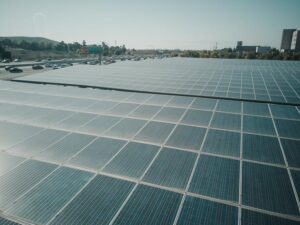Sunlight streams silently across space, bathing the Earth in a blanket of energy that’s both boundless and benign. You’ve likely seen solar panels perched on rooftops or sprawling across fields, their surfaces gleaming as they capture this solar energy.
But have you ever wondered how these sleek slabs convert the sun’s rays into electricity you can use to power your home, charge your phone, or even run a car? The secret lies in the photovoltaic effect, a process where materials known as semiconductors transform sunlight directly into electrical current.
As you learn about the journey of an electron set free by a photon’s touch, moving through an electric circuit, you’ll start to grasp the sheer elegance of this technology. And yet, what happens in the moments when sunlight meets the solar cell is just the beginning of the story. To truly understand the potential and limitations of solar power, you need to consider what happens next.
Listen To The Summary
Understanding the Photovoltaic Effect
At the heart of every solar cell lies the photovoltaic effect, which is the process that lets these devices convert sunlight directly into electricity. Imagine, if you will, the sun beaming down its energy. This light, full of tiny packets called photons, strikes the surface of the solar cell and gets absorbed. This is where the magic starts – with light absorption.
The material that makes up a solar cell has something called an energy bandgap. This is critical because it determines how much energy from the sun the material can use. When the photons have enough energy, they can cross this gap. If it’s just right, they knock electrons loose inside the material. These free electrons are what create an electric current.
Now, you’re not just harnessing the sun’s power; you’re directly transforming it into a form that can light up homes and power up gadgets. This is more than science; it’s a service, providing a cleaner, renewable source of energy.
Converting Sunlight Into Electricity
Having grasped the photovoltaic effect, let’s explore how solar cells harness this phenomenon to turn sunlight into usable electricity. When sunlight hits a solar panel, it’s not just about basking in the warm glow; it’s a prime opportunity for solar cells to get to work. They take in photons—tiny packets of solar energy—and convert them into an electric current. This is where solar spectrum utilization plays a pivotal role.
Different materials in solar cells absorb different parts of the solar spectrum. The aim is to use materials that capture a broad range of wavelengths, ensuring maximum energy conversion. Here’s a simple breakdown to illustrate the process:
|
Step
|
Description
|
|---|---|
|
Absorption
|
Solar cells absorb sunlight, using materials optimized for solar spectrum utilization.
|
|
Generation
|
The absorbed light generates electron-hole pairs within the cell material.
|
|
Collection
|
An internal electric field propels these charges, creating electricity that can be used or stored.
|
But there’s a catch shading impact. If part of a panel is shaded, it doesn’t just affect that section; it can significantly reduce the output of the entire panel. That’s why it’s critical to place your solar panels where they’ll receive uninterrupted sunshine, serving the community with a reliable stream of clean energy.

The Role of Semiconductor Materials
Semiconductor materials are the heart of solar cells, deftly managing the conversion of sunlight into electricity with their unique electrical properties. At the core of their function lies Band Gap Theory, a concept you might find as fascinating as it’s critical.
Picture the band gap as a sort of energetic hurdle electrons need to overcome to contribute to electric current. Too low, and the material conducts like a metal; too high, and it insulates like glass. Semiconductors, like silicon, have a ‘just right’ band gap that allows them to harness sunlight effectively.
Now, let’s talk about the doping process, no, it’s not what you’re thinking! This is a technique where you intentionally introduce impurities into the semiconductor. It’s like giving it a pinch of salt to enhance the flavour of a dish. Doping tweaks the material’s electrical properties, creating regions with excess positive charges (p-type) or negative charges (n-type).
When these two types are put together in a solar cell, they create a junction where the magic happens: electrons knocked loose by sunlight flow, and voila, you’ve got electricity! By understanding and optimizing these materials, you’re contributing to a cleaner, brighter future for everyone.
Electron Movement and Current Flow
Let’s dive into how electrons take the leap and create a current once they’re energized by sunlight. You see when photons from the sun hit the solar cell, they gift their energy to electrons in the semiconductor material. This energy boost allows electrons to jump from the lower energy bands where they normally chill out, up to higher energy bands where they can move freely. This jump is what you’d call charge separation since the excited electrons leave behind positively charged ‘holes’.
Now, in a solar cell, there’s a special junction where two types of semiconductor materials meet. This junction sets up an electric field, acting like a one-way street that guides the free electrons to flow in a certain direction. When you connect a load, like a light bulb, to the solar cell, these electrons hustle through the circuit, powering your bulb, before returning to the cell.
This flow of electrons is what generates electricity. It’s the heart of how solar cells serve up clean energy. By harnessing the sun’s power, we’re not just creating electricity; we’re fueling a brighter, more sustainable future for everyone. Aren’t you excited to be a part of that?
Measuring Solar Panel Power Output
To understand a solar panel’s efficiency, you’ll need to know how its power output is measured, typically in watts of electrical energy produced. When you’re aiming to serve your community by installing solar panels, it’s essential to comprehend the factors that influence their performance:
- Understanding Power Output
- Rated Power: The maximum output under ideal conditions, usually specified by the manufacturer.
- Real-World Conditions: Actual output can vary based on environmental factors.
- Monitoring Systems: Essential for tracking performance and energy production over time.
Efficiency factors play a crucial role in this equation. You’ve got to consider how well the solar cells convert sunlight into electricity, and this can be influenced by the materials used and the technology behind the panels. But remember, the numbers on the spec sheet aren’t the whole story.

Temperature impacts can’t be understated either. Solar panels often operate less efficiently as they get hotter. So, on a scorching day, even if there’s plenty of sunlight, your panels might generate less power than expected. That’s why it’s important to look at the temperature coefficient, which tells you how much output will change with temperature.
Frequently Asked Questions
How Do Weather Conditions, Such as Cloud Cover or Rain, Affect the Efficiency of Solar Cells?
Cloudy skies and rainfall can reduce your solar cell’s efficiency, but don’t worry, they’re built with resilience to still capture energy even on less sunny days, ensuring you can keep serving others.
Can Solar Cells Store the Energy They Generate for Use During Nighttime or on Days With Little Sunlight?
You can’t directly store solar energy for later use, but with battery integration and smart energy management, you’re able to harness the power for nighttime or cloudy days, keeping your service continuous.
What Are the Environmental Impacts of Manufacturing and Disposing of Solar Cells?
You’re helping others by understanding that resource extraction and recycling challenges affect solar cell production and disposal, leading to environmental impacts you’ll want to consider in sustainable energy discussions.
How Do Solar Cells Perform Over Their Lifespan, and What Is the Typical Degradation Rate of Their Power Output?
Your solar panels’ lifetime performance will generally decline due to degradation factors. Typically, you’ll see about a 0.5% to 3% annual power output drop, serving others sustainably for about 25 to 30 years.
Are There Any Innovations on the Horizon That Could Significantly Increase the Efficiency or Reduce the Cost of Solar Cells?
You’ll be thrilled to hear that perovskite layers and quantum dots are game-changers, potentially boosting solar efficiency and slashing costs, making clean energy more accessible for those dedicated to serving others.
Conclusion
Now you’ve seen how solar cells harness the sun’s energy to power your world. The photovoltaic effect is key, turning sunlight into electricity using semiconductor materials. When photons hit, they free electrons, creating current flow.
You measure this power in wattage, which tells you how much energy your panels can produce. Embracing solar is a bright idea, and you’re now clued into the science that makes it all work.



